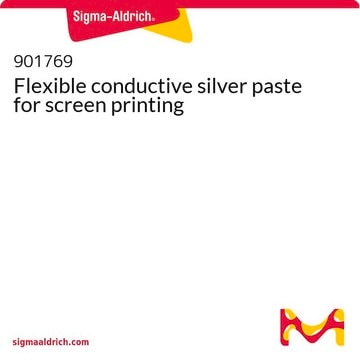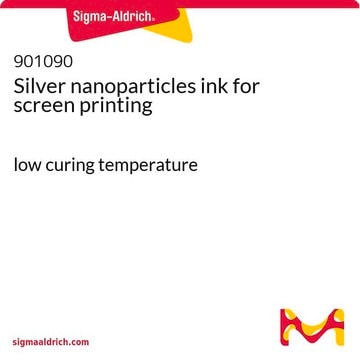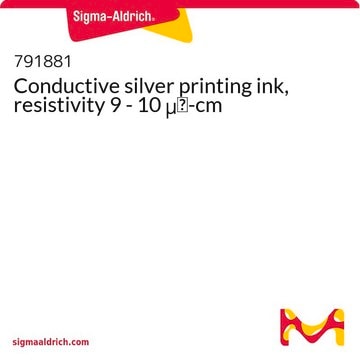735825
Silver
conductive paste
Synonim(y):
Silver Paste DGP80 TESM8020
About This Item
Polecane produkty
Postać
paste (microparticles)
charakterystyka ekologicznej alternatywy
Design for Energy Efficiency
Learn more about the Principles of Green Chemistry.
sustainability
Greener Alternative Product
stężenie
≥75%
rezystywność
1-3 * 10^-5 Ω-cm (conductive paste)
1.59 μΩ-cm, 20°C
macierz
α-Terpineol
wielkość cząstki
200 nm (80%)
<5 nm (20%)
lepkość
100,000-300,000 cP, 0.4 rpm(25 °C, Brookfield)
tw
2212 °C (lit.)
mp
960 °C (lit.)
temp. przejścia
curing temperature 120-150 °C (30-60 min)
gęstość
10.49 g/cm3 (lit.)
kategoria ekologicznej alternatywy
, Enabling
temp. przechowywania
2-8°C
ciąg SMILES
[Ag]
InChI
1S/Ag
Klucz InChI
BQCADISMDOOEFD-UHFFFAOYSA-N
Opis ogólny
Recommended washing solvent = polar solvent (Ethanol, IPA, Methanol, etc)
Recommended substrates = ITO film & glass, plastic film
Zastosowanie
Informacje prawne
Hasło ostrzegawcze
Danger
Zwroty wskazujące rodzaj zagrożenia
Zwroty wskazujące środki ostrożności
Klasyfikacja zagrożeń
Aquatic Acute 1 - Aquatic Chronic 1 - Eye Dam. 1 - Skin Irrit. 2
Kod klasy składowania
11 - Combustible Solids
Klasa zagrożenia wodnego (WGK)
WGK 3
Temperatura zapłonu (°F)
205.0 °F
Temperatura zapłonu (°C)
96.1 °C
Certyfikaty analizy (CoA)
Poszukaj Certyfikaty analizy (CoA), wpisując numer partii/serii produktów. Numery serii i partii można znaleźć na etykiecie produktu po słowach „seria” lub „partia”.
Masz już ten produkt?
Dokumenty związane z niedawno zakupionymi produktami zostały zamieszczone w Bibliotece dokumentów.
Klienci oglądali również te produkty
Produkty
Small molecular weight organic semiconductors are promising for flexible transistor applications in next-gen soft electronics.
The diversity of applications and nanostructured materials accessible using ultrasonic spray methods are highlighted in this article.
While dye sensitization as the basis for color photography has been accepted for a very long time,1 attempts to use this principle for the conversion of solar light to electricity generally had resulted only in very low photocurrents, below 100 nA/cm
Ultrasonic spray pyrolysis produces scalable nanomaterials like metal oxides and quantum dots for diverse applications.
Nasz zespół naukowców ma doświadczenie we wszystkich obszarach badań, w tym w naukach przyrodniczych, materiałoznawstwie, syntezie chemicznej, chromatografii, analityce i wielu innych dziedzinach.
Skontaktuj się z zespołem ds. pomocy technicznej








